Computational chemistry is a very diverse field that uses computer simulation to assist in solving chemical problems. By using methods of theoretical chemistry, incorporated into computer programs, we can calculate the structures and properties of molecules. In general, computational results normally complement the information obtained by chemical experiments, It is widely used in the design of new drugs and materials. The focus of Frontiers in Computational Chemistry is to present different techniques used in drug discovery and the drug development process. Topics falling under this umbrella include computer aided molecular design, drug discovery and development, lead generation, lead optimization, database management, and the development of new computational methods or efficient algorithms for the simulation of chemical phenomena including analyses of biological activity. In this volume, we have collected six different perspectives in the application of computational methods towards drug design.
Chapter 1: Computer-aided molecular design in computational chemistry
This chapter combines thermodynamics, and numerical optimization to design good or optimal molecular structures with many of them are completely novel. Advances in chemical modeling in the last few decades have greatly benefited CAMD relating chemical structures to properties at several levels of accuracy (molecular mechanics, semi-empirical, ab initio). Though CAMD often uses semi-empirical modeling techniques for their simplicity and efficiency, new approaches incorporating more accurate methods are emerging. In this chapter, the significant advancement, applications of CAMD in the single component product designs, challenges in progression, and the future perspective in designing the chemical compounds by using “computer-aided molecular design” (CAMD) tools is provided.
Chapter 2: Role of Ensemble Conformational Sampling Using Molecular Docking & Dynamics in Drug Discovery
Molecular recognition involved in protein interaction with each other or various small molecules with a high specificity and affinity to form a specific complex, constitutes the basis of all processes in living organisms. These interactions can be studied through multiple computational approaches including docking, MD simulation etc. In this chapter, the theoretical background of molecular docking, classical MD simulations, MD-based enhanced sampling methods and hybrid docking-MD based methods are highlighted, demonstrating how protein flexibility has been introduced to optimize and enhance accurate protein-ligand binding predictions. Overall, the evolution of various computational strategies is discussed, from molecular docking to molecular dynamics simulations, to improve the overall drug discovery and development process.
Chapter 3: Molecular Dynamics Applied to Discover Antiviral Agents
Molecular Dynamics (MD) remains a valuable tool in optimizing the ligand-protein complexes and understand the ligand binding modes and drug resistance mechanisms in viruses. It is useful for filling in the details about the microscopic events that take place in mere millionths of a second, which experimental methods cannot. Molecular dynamics (MD) simulations utilizes simple approximations based on Newtonian physics to simulate atomic motions. This chapter deals with the concept and applications of MD simulations, as well as their applications in the discovery of drugs against Coronaviruses (SARS-, MERS-CoV, and SARSCoV-2); Influenza (INFV); Chikungunya (CHIKV); Zika (ZIKV); Dengue (DENV); Ebola (EBOV); and human immunodeficiency virus (HIV). This will contribute a great source of helpful information that could be utilized for designing new compounds against neglected diseases.
Chapter 4: Pharmacophore modeling approach in drug discovery against the tropical infectious disease malaria
Despite remarkable improvement in overall global health, Malaria remain a major health problem in the developing world. The crucial role of chemotherapy in curtailing the deleterious health and economic impacts of malaria has invigorated the search for new antimalarial drugs. Among computational approaches pharmacophore modelling is widely employed in identifying the new molecules that trigger the desired biological activity. Due to their simplistic and abstract nature, pharmacophores are both perfectly suited for efficient computer processing and easy to comprehend by life and physical scientists. This chapter aims to provide the pharmacophore concept, pharmacophore modelling methods and its applications in modern computer-aided drug design.
Chapter 5: Advances in computational network pharmacology for Traditional Chinese Medicine (TCM) research
Traditional Chinese Medicine (TCM) is well-known for its use of medicinal herb combinations to treat the functional disorders which naturally followed the principal of network pharmacology. In this chapter, systematically the methodologies of network pharmacology in TCM studies are discussed followed by its application on TCM against COVID-19. The forefront study examples are also included to collate and analyze the advantages and limitations of different computational techniques.
Chapter 6: Progress in Electronic-Structure Based Computational Methods: From Small Molecules to Large Molecular Systems of Biological Significance
In recent years, understanding of biological systems using electronic structure theory based computational methods with applications to biology and medicine has gained increased interest. Recent computational approaches that account for the effects of electron correlation to a high degree and computational methods that seek to describe large molecular systems with reduced computational cost seek further attention. In this chapter special attention to the computational methods capable of describing phenomena relevant to biological activity and drug discovery and development, as well as the design of new materials relevant to understanding complex biological systems are highlighted.
Zaheer Ul-Haq
Dr. Panjwani Center for Molecular Medicine and Drug Research
International Center for Chemical and Biological Sciences
University of Karachi
Karachi
Pakistan
&
Angela K. Wilson
Department of Chemistry
Michigan State University
East Lansing, MI
USA

